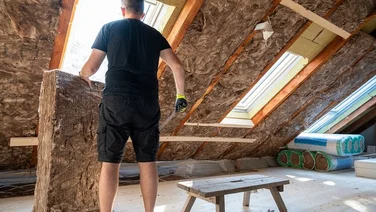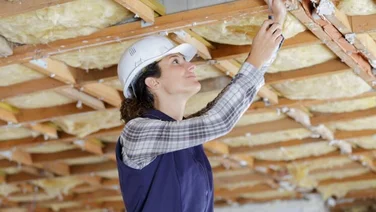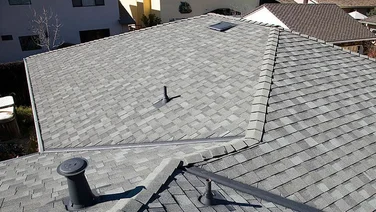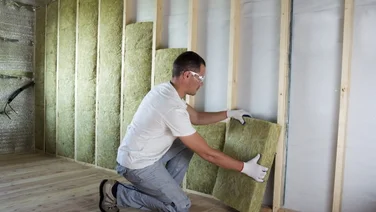- Spray foam insulation is one of the most cost effective floor insulation options
- Rigid foam insulation is very cost effective and efficient
- Draught proofing is a simple and inexpensive way to insulate your floors
When it comes to insulating your floors, there are many different options, all of which bring big benefits.
In fact, the Energy Saving Trust estimates that floor insulation could save you up to £70-£100 on your energy bills every year – meaning you can soon pay off the cost of installing insulation, and then some.
You can also determine the cost of various forms of insulation using our guide: The cost of spray foam insulation.
The good news is there’s a wide range of insulation options to help you reduce heat loss through your flooring. Read on as we explore the eight best floor insulation options for 2024.
If you wish to jump straight into finding out how much it might cost to insulate your home, simply enter your information in this quick form, and our suppliers will reach out with free spray foam insulation quotes.

What are the best types of floor insulation?
The best types of floor insulation will be dependent on several factors, so it’s best to work with a professional company for your property specifically.
But in general, the best types of floor insulation are:
- Spray foam insulation: A liquid form of insulation (made of polyurethane) that expands and then dries to provide a tight heat barrier.
- Blanket insulation: A type of insulation composed of fibre material, like fibreglass or mineral wool, that comes in batts or rolls.
- Rigid foam insulation: A type of insulating material made from polystyrene, polyisocyanurate, or polyurethane that’s available as rigid boards or spray.
- Multi-foil insulation: An insulation type incorporating a reflective surface that prevents heat loss via radiation.
- Draught-proofing: The process of filling gaps in floors that let in cold air and let out warm air with a sealant or wooden beading.
- Rugs and carpets: A simple and cost-effective insulating option that can help improve energy efficiency in your home.
- Insulating screed: A cement-like substance that is spread over a floor for insulation as well as for levelling purposes.
- Structural Insulated Panels (SIPs): Building panels consisting of a core of rigid foam insulation sandwiched between two sheets of oriented-strand board (OSB) that can be installed on floors to provide insulation as well as structural support.
Spray foam insulation
Spray foam insulation is made of polyurethane and is usually sprayed as a liquid that gradually expands significantly beyond its original volume. Once it dries and cures, it creates a highly effective thermal, noise, air, and moisture barrier.
Spray foam insulation boasts a higher R-value per inch than most other types of insulation. R-value refers to the ability of an insulation material to resist heat flow. The higher the R-value, the better the insulating properties of the material.
There are two main types of spray foam insulation: open-cell and closed-cell.
The open-cell version expands much more, growing to as much as 100 times the initial volume and yielding R-values of up to 4 per inch. The closed-cell option expands less but is denser and creates a higher R-value per inch—as much as two times that of open-cell insulation.
Although it’s one of the most effective types of insulation, spray foam is also one of the more expensive, unfortunately, with costs running between £20 and £50 per square metre. You can find out more about this on our spray foam insulation costs page.
What are the pros and cons of spray foam insulation?
- High thermal resistance and air-sealing properties
- Provides long-term insulation with minimal maintenance
- Acts as a moisture barrier
- Professional installation is necessary
- Higher upfront costs than other insulation types
Spray foam insulation is renowned for its superior insulation performance, boasting an impressive R-value of up to R-8. It can adhere to irregular surfaces and is also extremely long-lasting. It also offers additional benefits, including acting as a moisture barrier, protecting the home from mould and mildew damage, and even deterring pests.
Blanket floor insulation
Blanket insulation, available as batts or rolls, has been one of the most widely used types of insulation in UK homes. It continues to be popular today because of its affordability and ease of installation.
This type of insulation comprises flexible fibres, with fibreglass being the most common option. However, you can also find other options like mineral wool (including rock and glass mineral wool), plastic fibres, and natural fibres like sheep’s wool and cotton, which are more eco-friendly types of insulation.
Installing this type of insulation involves laying it between floor joists and then holding it in place with netting. On average, blanket insulation costs about £5 per m2.
What are the pros and cons of blanket floor insulation?
- Relatively easy to install DIY
- Reasonable costs
- Fibres can become loose during installation, leading to irritation of the eyes, skin, and respiratory systems
- Can take up a lot of space to reach the desired R-value
Blanket insulation is easy to install, and its costs are quite reasonable.
However, you might need to install several layers of this material to reach the desired insulation value. Fibres can become loose during installation and irritate the eyes, skin, and respiratory systems. Therefore, make sure to wear personal protective equipment such as a dust mask, gloves, and safety glasses when installing blanket insulation.
Rigid foam insulation
Rigid foam insulation is made from either polystyrene, polyisocyanurate, or polyurethane. This type of insulation is available in spray form or in rigid sheets that come in thicknesses of 0.5 to 4 feet, and in various lengths and widths.
The two most commonly used options in homes are polystyrene—which is available as expanded polystyrene (EPS) and extruded polystyrene (XPS)—and polyisocyanurate.
Rigid foam insulation costs more than blanket insulation forms like fibreglass in terms of R-value, at around £5 and £21 per square metre. But it makes up for it by compressing more R-value into a smaller volume.
EPS is the least expensive of the three options but offers the lowest R-value (about R-4 per inch). XPS is intermediate both in terms of price and R-value (R-5 per inch). Polyisocyanurate is usually the costliest but offers superior insulation qualities (about R-6.5 per inch).
Rigid foam insulation is typically used on solid floors, like concrete, and can be fitted either below or above the floor. The material cuts easily with a sharp knife and is, therefore, easy to install.
What are the pros and cons of rigid foam insulation?
- High insulation value for relatively little thickness
- Water-resistant and can thus be used in damp conditions
- Easy to work with
- Flammable and might require fireproofing measures
- Prone to insect problems
Rigid foam insulation offers a good balance between insulation value and size. It’s also water resistant and can therefore be used in damp conditions. Furthermore, installation is relatively simple.
One downside of rigid foam insulation is that it’s flammable and can therefore be a fire hazard. Some rigid foam insulation has also been linked to insect problems. Termites and carpenter ants can tunnel through polystyrene and polyisocyanurate foams to create nesting cavities.
Multi-foil insulation
Multi-foil insulation consists of several layers of aluminium foil with wadding sandwiched in between.
It differs from most other types of insulation in that instead of reducing conductive heat transfer, it reduces radiant heat transfer, specifically by reflecting heat emitted from a warm surface back onto that surface.
It’s flexible and easy to cut with a knife, making installation easy. However, it needs to be positioned adjacent to an air gap to work; otherwise, the heat will be conducted through to the next solid layer it touches.
During the cold season, multifoil insulation can be a particularly great option when installed in areas like floor joist spaces above an unheated basement. Here, convection heat losses are minimal since warm air will tend to stay near the floor, making radiation the primary mode of heat loss. A single reflective barrier will therefore have a massive effect on reducing heat loss.
Prices for multi-foil insulation start at around £9 per square metre.
What are the pros and cons of multi-foil insulation?
- Thin and lightweight, and therefore easy to work with
- Relatively affordable
- May be an electrical hazard if contact is made with live wires running beneath the floor
- Little effect on conduction or convection heat losses
- Dulling of a reflective surface by dust or water vapour can reduce its effectiveness
One big advantage of multi-foil insulation is that it’s quite easy to work with. It’s also relatively affordable compared to other forms of insulation, like spray foam insulation.
That said, multi-foil insulation can be an electrical hazard if contact is made with live wires (since aluminium is an electrical conductor). Additionally, while this insulation does a superb job of preventing heat loss via radiation, it has little effect on heat loss via conduction and convection. Dust or water vapour on the reflective surface can also reduce this insulation’s effectiveness.
Draught-proofing
Draught-proofing entails blocking any unwanted gaps on your floorboards and skirting boards that let in cold air and let out warm air. This can be achieved using a silicon sealant or wooden beadings. Both options are cheap and quite easy to install.
What are the pros and cons of draught-proofing?
- Easy to install
- Cheap
- May not address all sources of heat loss
- Might require regular maintenance to ensure proper sealing
The main advantages of draught-proofing are its affordability and ease of installation. You can draught-proof your floors using a sealant bought from a local DIY store for less than £10.
One big downside of this type of insulation, however, is that it won’t address all sources of heat loss. In addition, it’s not a one-time process. Regular checkups are necessary to identify and seal more gaps that might appear on floorboards or skirting boards over time.
Rugs and carpets
Rugs and carpets present another simple and economical way to reduce heat loss from your floors, improve energy efficiency, and save on energy bills.
They are relatively easy to install— the only time they might be disruptive is if you have heavy furniture that needs to be moved first. Carpets and rugs are also relatively easy to maintain with regular vacuuming.
These materials come in a variety of sizes and types, so costs can vary. You may pay anywhere from £5 to over £100 per square metre for a rug or carpet.
What are the pros and cons of carpets?
- Affordable and easy to install
- Can enhance comfort and aesthetics
- Easy to replace or update
- Lower insulation effectiveness compared to other types of insulation
- Might not be practical for areas prone to getting wet
Rugs and carpets provide a low-cost, hassle-free way to insulate your floors. Beyond their insulation benefits, they come with added benefits, including improved underfoot comfort, noise reduction, and adding some colour and style to your home.
However, their overall insulating properties are significantly lower than other types of insulation. They are also not practical for areas that are prone to getting wet regularly.
Structural Insulated Panels (SIPs)
Structural insulated panels are a type of building material that combines structural support and insulation in a single panel. They consist of a core of rigid foam insulation—typically expanded polystyrene (EPS)—sandwiched between two sheets of oriented-strand board (OSB).
SIPs are usually pre-fabricated in the factory and then sent to the site. Installation is easy and fast and involves joining the panels together using specialised fasteners, adhesives, or splines. The panels then form a continuous, airtight, and highly insulated building envelope.
What are the pros and cons of structural insulated panels?
- Excellent insulation
- High strength-to-weight ratio
- Easy and quick installation
- Higher upfront cost
- Prone to insect damage
SIPs provide several advantages. Their excellent thermal performance helps to create energy-efficient buildings, reducing heating and cooling costs. The prefabricated nature of SIPs allows for faster construction, saving time and labour expenses. Additionally, their structural integrity makes them capable of withstanding heavy loads, providing durability and long-term stability.
However, SIPs also have some limitations. The higher initial cost may deter some homeowners. They might also be prone to insect damage—so treating the panels as well as the ground before and after installation might be necessary.
Insulating screed
Insulation screed is made from sharp sand, cement, and water. It’s available in two formats: a semi-dry version, which is applied manually using a float and trowel, and a liquid version, which is applied via pumping.
To achieve optimum insulation value, screed is typically used alongside another type of insulation, like rigid foam insulation. Besides its insulating properties, it can also be used as a leveller for uneven floors.
The cost of insulating creed material ranges between £12 and £16.50 per square metre.
What are the pros and cons of insulation screed?
- Provides both insulation and levelling properties
- Durable and long-lasting
- Usually needs to be installed alongside another type of insulation
- Can add height to the floor and affect other home functionalities, like door clearance
- Usually requires professional installation
Insulation screed is durable and long-lasting. In addition to helping conserve heat, it can also be used as a levelling agent for uneven floors.
However, it often needs to be used alongside another insulating material to achieve maximum insulation value. The other disadvantage is that it can add height, potentially affecting other aspects of the home, like door clearance. It also typically requires professional insulation.
Summary
- Insulating your floors can help prevent heat loss, improve energy efficiency, and lower your energy bills
- As seen, there is a wide range of floor insulation options to choose from, each with its own advantages and disadvantages
- Assess each of the options we’ve explored here to see which one could be a good fit for your home
- The best type of floor insulation for you depends on your needs and your personal circumstances, including your budget
- If money isn’t an issue, spray foam insulation is one of the most effective options. If you’re looking for an option that offers a good balance between cost, space and insulating properties, you can go for rigid foam insulation
- If you’d like to find out how much it’ll cost you to get spray foam insulation, the next step is to simply fill out this simple form. We’ll forward your details to home insulation pros who’ll then get back to you with free quotes.







